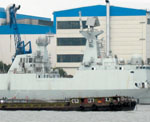 |
| Russian technology incorporated aboard this modern Chinese frigate includes a three-dimensional radar, Bandstand tracking radars and the MR90 missile guidance tracker-illuminator for surface-to-air missiles. China’s reverse engineering of these systems is creating strains with Russian exporters. |
As the Middle Kingdom sells pirated materiel,
Russia shifts export patterns.
China has been buying and adapting Russian naval technologies as it introduces new ships to the fleet in fits and starts. Instead of standardizing ship designs and deploying large numbers of similar ships to its emerging blue water fleet, the People’s Liberation Army Navy keeps introducing new types of guided missile destroyers largely in pairs. The answer to the question of why China produced only one or two of four recent new guided missile destroyer designs could be that China is trying to gain the capability of producing a 956-type ship so that no more expensive Russian imports would be needed.
Russian officials have been irritated for years by what they view as China’s illegal reverse engineering of combat systems. After selling a few systems to China, Russia had counted on follow-on orders for more systems, which is the ethical business practice of other nations. In addition to costing Russia the loss of future sales to China, Chinese copies compete with Russia in sales to other Third World navies. China in turn has complained that Russia has overcharged it for ships and systems that were sold for less to other nations.
The Russian state military import/ export agency Rosvoorouzhenie and 956E production Severnoye Design Bureau were shocked and angered when the 054A upgrade to the new People’s Liberation Army Navy (PLAN) 054 frigate appeared in 2006 (SIGNAL Magazine, May 2007). At first it appeared to have four Russian-supplied systems that had been on earlier Chinese Luyang guided missile destroyers (DDGs). In reality, the four complex systems were illegal Chinese copies never before seen, and all were on a new serial production series of frigates. This was the straw that broke the bear’s back, and it could result in Russia shifting high-technology exports from China to India.
Russian military exports to China peaked in 1996 at 70 percent. By 2006 this had dropped to 40 percent, and in 2007 the exports dropped by half to 20 percent. Other factors may be involved, but Rosvoorouzhenie dissatisfaction with the loss of expected future sales is certainly apparent.
Chinese Premier Hu’s March 2007 visit with top-level Russian officials on new military cooperation programs reached no new agreements. This contrasts with previous meetings that announced large new Chinese military purchases. An expected order of an additional Su-30MK2 aircraft did not happen. However in 2007, India signed for 40 additional Su-30MK1 fighters from Russia.
The Sovremennyi high-technology combat systems copied by China on the surprising 2006 054A upgrade may seriously disrupt future high-technology imports to China by Russia. The four copied systems are the MGK-335 sonar, the Fregate M2EM three-dimensional (3-D) radar, Mineral ME (Bandstand) tracking radars and the Russian MR90 missile guidance tracker-illuminator for the SAN-7 Rif-M Shtil surface-to-air missile (SAM).
Designed by Morphizpribor Central Research Institute, the complete MGK-335 sonar suite has a towed variable depth sonar (VDS) in addition to its hull array. Because no stern VDS hoist is visible, the Chinese 956E ships must have the reduced MGK 335MS with only the hull sonar dome. This complex 1.5-10.9 kilohertz medium-frequency sonar has sufficient power and digital signal processing to enable near-convergence zone detection capability. The first PLAN vessel to use an imported sonar set was the 2002 052B DDG. The 054A frigate in 2006 was the first illegal reverse-engineered version manufactured in China.
The Fregate M2EM 3-D radar offers two channels in E and H bands that can track more than 100 contacts with maximum range of 300 kilometers (200 miles). The equipment and antenna weigh 6.6 tons and 2.3 tons, respectively. It was designed by Salyut Moscow and first provided to China on four 956E ships in 2000. China imported 10 sets of the Fregate 3-D radar, with two placed on 052B DDGs in 2002 and two placed on 051C DDGs in 2006. The first reverse-engineered Chinese copy appeared on the 054A frigate in 2006.
Mineral ME Bandstand tracking radars provide missile control and over-the-horizon radar acquisition and target designation of surface ships. They can track up to 200 contacts and coordinate with up to nine other ships. The ME-1 active radar operates in I band with a 250-kilometer (155-mile) range; the ME-2 passive radar operates in D-G and I bands with a 450-kilometer (280-mile) range; and the ME-3 data exchange and orientation radar operates in I band with a 30-kilometer (20-mile) range. Designed by Typhoon Instrument Making Plant JSC Kaluga, the first of four were provided to China on a 956E in 2000. Imported Mineral radars appeared on two 052B DDGs in 2002 and on two 052C and two 051C DDGs in 2006. The Chinese reverse-engineered version appeared on the 054A in 2006.
 |
| The vertical launch system (VLS) forward of the bridge is similar to the U.S. MK 41 VLS. |
The Russian MR90 missile guidance tracker-illuminator for the SAN-7 Rif-M Shtil SAM was designed by the Altair Marine Radio-Electronics Research Institute JSC.
China imported eight S-band MR90s from
Russia for four 956E DDGs in 2000. Two MR90 radars were tested for several years on the Chinese experimental ship 891. The first installation of a Chinese copy of the MR90 supported the HQ-16 vertical launch system (VLS) on the 054A in 2000.
This touches on what may be another piece of reverse engineering. The four rectangular VLS modules of the HQ-16 on the 054A appear identical to the U.S. Navy MK 41 VLS, but the United States has not commented on the obvious similarity. The MK 41 has been exported for many years to numerous nations, and a copy could have been expected sooner—such as on the 052C Luyangs. In fact, this rectangular-hatch VLS has been evaluated, along with an MR90 tracking radar, on the 6,000-ton weapon experimental Wuhu-B hull 891 for more than a year. Some experts assumed that this MR90 was a Soviet import, but it probably is the Chinese copy undergoing testing prior to installation on the 054A. Although the type of VLS SAM has not been identified, it would probably be the SAN-7, which is associated with the MR90 illuminator.
The 054A frigate has the Type 730 close-in weapon system (CIWS), based on the Netherlands Goalkeeper, which uses the U.S. GE GAU Phalanx gun. The Type 730 was on the 052B and 052C in 2002 and 2003, and it was on the 051C prior to the 054A frigate in 2006. Type 730 radars are very similar to the Signaal I-band search radar and dual I- and K-band track radar.
These recent stunning reverse-engineering successes do cause complications. One result is that combat system sensors are not matched on the hull and machinery generators, notably for MTU and SEMT diesels. Shaanxi Diesel Plant, also called Factory 408, has been licensed to serially produce French SEMT Pielstick and German MTU series diesels since 1974. In 1989, a second factory, Shanghai Hudong Heavy Machinery Company, was authorized to produce PA6STC diesels. Four of these diesels are on each 054/054A frigate.
SEMT Pielstick PC2-5 series diesels have 6-, 12- and 16-valve models, and MTU 956 diesels have 12-, 16- and 20-valve models (TB82, -32 and -92). The 052A has MTU 12-valve 1163 TB83 diesels, and the 052B has MTU 20-valve 956 TB92 diesels. Chinese factories produced them, and difficulties have been reported with them.
After all of these years, China still imports some SEMT and MTU diesel components from France and Germany. During 2006 and 2007, China imported 15 to 20 sets of German MTU 16-valve and 8-valve 396 SE84 diesels for new submarines such as the modern Yuan diesel boats. The same situation exists with China importing parts for 24 model 16 PA6STC diesels, which were used on the newest 054/054A frigates. Apparently China has not yet successfully produced these submarine or surface ship diesels without imported components.
Other notable Chinese PLAN reverse engineerings of foreign weapon systems include the Crotale/HQ-7/Castor C radar. Two sets of Crotale missile launchers were imported from France in the 1980s. Crotale missile launchers and associated Thomson CSF DRBC 32F Castor C fire control radars were installed on the Luhu DDG 112 in 1991. An upgraded Luda, hull 109 added a topside 8-round reload box aft of the launcher. The six Jiangwei II frigates launched from 1991 to 2000 had HQ-7 by China, with no reload storage. In 2002 the Crotale was replaced with indigenous HQ-7A on DDG 112. The 1993 Luhu DDG 113 and 1997 Luhai DDG 167 HQ-7 had reload rounds in below-deck hatches, which was not even available in French Crotale systems.
Two SS-12 variable depth or dipping sonars were imported from France in 1974. Three SS-12s were installed on Z-9 shipboard helicopters, and in 1987 Haiju craft hulls 688 and 697 replaced aft 57-millimeter guns with the SS-12. China procured one French Thomson CSF TAVITAC CDS computer, which was installed on the Luda I destroyer DD 105 upgrade in 1987. The first Chinese copy of TAVITAC was installed on Luhu DDGs 112 and 113 as the ZJK4 in 1991 and 1993.
China imported 40 A244 torpedoes from Italy around 1980. An improved A244/S was produced in 1984. Reportedly, the A244/S is produced under Italian license as the Yu-7 antisubmarine warfare (ASW) torpedo. Some reports of U.S. Navy MK 44 torpedoes being produced by China could be mistaken because both the MK 44 and the A244 have a similar shroud around the propeller. Some references state that Yu-7 PLAN ASW torpedoes are copies of the U.S. Navy MK 46 Mod 2, four of which were sent to China in 1986 for co-production. Because the sale was below the $14 million Arms Export Control Act threshold, Congress did not review the deal. Negotiations between the United States and China broke down, and Chinese attempts to change the hardware to metric measurements reportedly stopped in 1988.
India has been the recipient of many Soviet/Russian naval ships, aircraft and systems since 1965 (SIGNAL Magazine, December 1993, page 41), but these have come at a lower level, especially since 2000. India has one Russian aircraft carrier hull undergoing costly renovation for more than 10 years. India received a Russian Charlie-class nuclear attack submarine (SSN) in 1988, but India returned it in 1991 because of high radiation levels that were dangerous to the crew. Russia has exported modern warships with full suites of combat systems to India, including Mod Kashin destroyers (1986), the Krivak III (2000) and eight Foxtrot diesel submarines.
Prior to exporting two Sovremmennyis to China in 2001, Russia had limited its exported ships to auxiliaries and 1950s-vintage frigates, patrol vessels and Whiskey- and Quebec-class diesel submarines. The only destroyers Russia provided China were four World War II-vintage Gordyi-class ships in 1948. But India has had Russian CIWS 630 Gatling guns since 1986.
The trend of India becoming Russia’s favored high-technology export market is noted by recent negotiations for Russia to export two Akula II SSNs to India. These advanced nuclear submarines never have been available to China. India has been procuring and gaining production licenses from Russia and several Western nations for decades, and it never has copied any systems illegally. India’s Bharat Electronics Limited (BEL) and the country’s excellent Mazagon and Garden Reach shipyards have been successful in development and production of warships and systems. This contrasts with China’s record of illegally reverse engineering and producing systems without license from many nations.
Neither India nor China has built an aircraft carrier, but China has had more success at designing SSNs than India’s trouble-prone Advanced Technology Vehicle SSN attempt for more than 10 years. China’s recent gaining of a naval base in Myanmar, which is in India’s traditional sphere, points to the likelihood that future Chinese oil sea lanes to the Middle East will go through the Indian navy waters routinely.
The Soviet/Russian exporting of modern offensive systems to nations other than China has been obvious over several decades. One reason is that China has presented a possible threat to Russia with common border disputes and competition for Far Eastern power status. These circumstances do not apply to other customers.
Another reason could be that other customers will continue to rely on Russia for new systems. They will not copy illegally and refuse to buy more systems; nor will they compete with Russia in export sales to other nations. If this is a Russian concern, then the Sovremennyi exports resulting in the five copied systems on 054A frigates five years later justify Russian fears.
James C. Bussert is employed at the Naval Surface Warfare Center, Dahlgren, Virginia, where he works on surface ship antisubmarine fire control systems.






Comments